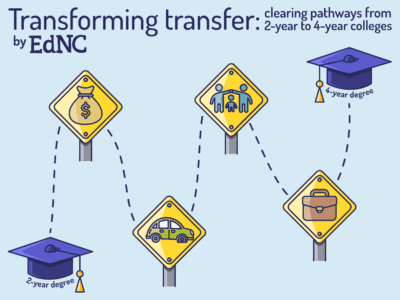

|
|
More than 22,000 new undergraduate transfer students enrolled at UNC System institutions during the 2021-22 school year. On Thursday, the UNC System announced a new database to help such students transfer across North Carolina public institutions more easily.
The online database, called the UNC Common Numbering System, includes over 1,600 undergraduate, lower-level courses from institutions within both the UNC and North Carolina Community College systems.
“The launch of the Common Numbering System is a triumph for students and institutions across our great state,” UNC System President Peter Hans said in a release. “Students have long dealt with a complex transfer process that didn’t always recognize credits completed at another UNC institution or a community college. This important tool will help expand access to our world-class institutions, benefiting the one-third of our students who will transfer from a community college or another UNC System institution during their college experience.”
In 2021-2022, there were 574,181 students enrolled in the North Carolina Community College System (NCCCS). That same year, approximately 13,000 of the UNC System’s new transfer students came from the NCCCS. That’s nearly 60% of the UNC System’s new transfer students.
Like many higher education institutions, the UNC system saw recent decreases in total undergraduate student enrollment. Those decreases were offset by graduate student enrollment, which set a new record and grew for the eighth consecutive year. Fall 2021 marked the largest total enrollment in the history of the UNC System — 244,508 students across 16 institutions. That enrollment marked a 0.85% increase from the previous year, or a gain of 2,062 students.
New transfer student enrollment, however, declined for the third year in a row.
Community college students can count many course credits toward a four-year degree from UNC System universities. The new online database is a nearly two-year effort to help students more seamlessly transfer without losing academic credit.
‘At last, it’s a reality’
In 1995, the General Assembly strengthened the role of community colleges in preparing students to transfer to universities by establishing common course numbering among the community colleges. Legislation also required the UNC Board of Governors and State Board of Community College to “develop a plan for the transfer of credits” between the two systems.
This led to the first Comprehensive Articulation Agreement (CAA), signed in 1997. The agreement set rules for transferring credit between the NCCCS, 16 UNC System schools, and signatory North Carolina independent colleges and universities. In 2007, the state’s independent colleges and universities and the community college system signed the first Independent Comprehensive Articulation Agreement (ICAA). In 2013, the General Assembly passed a law requiring biannual reviews of the CAA. That agreement was substantially revised in 2014.
The CAA guarantees admission to one UNC System school for NCCCS students who complete associate degrees in arts or science. That college is not necessarily the student’s school of choice, however.
For students who transfer before earning an associate degree in arts or science, or for students who earn workforce or technical degrees, loss of credits upon transferring has been a problem. It’s a problem the Common Numbering System (CNS) hopes to address.
Now, when students transfer between two participating CNS institutions, they can search in advance which courses are equivalent or transferrable.
The database includes lower undergraduate courses most often transferred between the UNC System institutions.
“The UNC System’s Common Numbering System will save time and money for transfer students, helping them to plot the most efficient path toward a degree,” said David English, acting senior vice president for academic affairs. “For two decades, this idea has been a conversation piece. At last, it’s a reality.”
North Carolina educational attainment goal
The Common Numbering System joins the UNC’s System’s recent efforts to meet the state’s educational attainment goal of 2 million North Carolinians ages 25 to 44 with a meaningful, high-quality credential or postsecondary degree by 2030. That’s about 67% of adults in that age bracket, according to projections from Carolina Demography.
More than 39 million adults in the U.S. have at least some college credit and no degree or credential, according to the National Student Clearinghouse Research Center. There are slightly more than 1 million North Carolina adults with some college but no degree or credential as of July 2020. Nearly 34% of those adults are younger than 35 and about 54% are ages 35 to 64.
Last month, the system launched a statewide initiative to offer one-on-one success coaching to help students with some college and no degree or credential complete their studies at one of eight system schools.
In 2021, the General Assembly appropriated $97 million for the launch of Project Kitty Hawk, a nonprofit ed-tech startup partnering with the UNC System to design workforce-aligned online programs and attract and support adult learners. Project Kitty Hawk aims to help the UNC System reach its goal of expanding to 45,000 adult students by 2027. The organization plans to roll out operations over the next five years, Director of Strategy Brian Fleming told the State Board of Community Colleges last month. Annual tuition is expected to cost between $8,000 and $10,000, project leaders said at a legislative oversight committee last week.
When the initiative launched last November, many community college employees worried the startup would detract from the system’s adult learner efforts. Fleming said he wants to understand that “competitive dynamic” and work with the community college system instead of against it. That sentiment is one the UNC System has repeatedly made regarding its adult learner and workforce initiatives.
“I hope this will be the beginning of the conversation,” State Board Chair Burr Sullivan said in August. “In my view it ought to get much more specific and intentional so that we are not competing with each other for the same student.”








